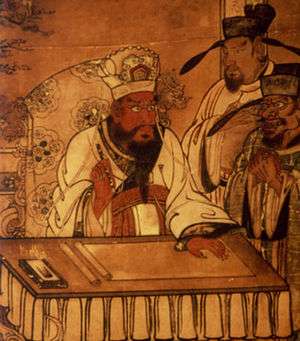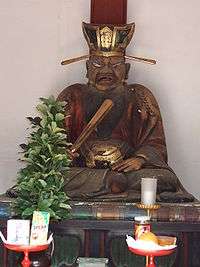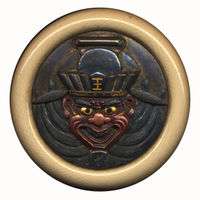Yama (Buddhism)
In East Asian and Buddhist mythology, Yama (sometimes known as the King of Hell, King Yan or Yanluo) is a dharmapala (wrathful god) said to judge the dead and preside over the Narakas ("Hells", "Hell Realm" or "Purgatories") and the cycle of afterlife saṃsāra.


Although based on the god Yama of the Hindu Vedas, the Buddhist Yama has spread and developed different myths and different functions from the Hindu deity. He has also spread far more widely and is known in most countries where Buddhism is practiced, including China, Korea, Japan, Taiwan, Vietnam, Bhutan, Mongolia, Thailand, Sri Lanka, Cambodia, Myanmar and Laos.
Yama in Theravāda Buddhism
In the Pali canon, the Buddha states that a person who has ill-treated their parents, ascetics, holy persons, or elders is taken upon his death to Yama.[1] Yama then asks the ignoble person if he ever considered his own ill conduct in light of birth, deterioration, sickness, worldly retribution and death. In response to Yama's questions, such an ignoble person repeatedly answers that he failed to consider the karmic consequences of his reprehensible actions and as a result is sent to a brutal hell "so long as that evil action has not exhausted its result."[2]
In the Pali commentarial tradition, the scholar Buddhaghosa's commentary to the Majjhima Nikaya describes Yama as a vimānapeta (विमानपेत), a "being in a mixed state", sometimes enjoying celestial comforts and at other times punished for the fruits of his karma. However, Buddhaghosa considered his rule as a king to be just.[3]
Modern Theravādin countries portray Yama sending old age, disease, punishments, and other calamities among humans as warnings to behave well. At death, they are summoned before Yama, who examines their character and dispatches them to their appropriate rebirth, whether to earth or to one of the heavens or hells. Sometimes there are thought to be two or four Yamas, each presiding over a distinct Hell.[4]
Yama in Chinese, Korean, Vietnamese and Japanese mythology

In Chinese mythology, King Yan (simplified Chinese: 阎王; traditional Chinese: 閻王; pinyin: Yánwáng) is the god of death and the ruler of Diyu, overseeing the "Ten Kings of Hell". He is also known as Yanluo (阎罗王; 閻羅王; Yánluówáng), a transcription of the Sanskrit for King Yama (यम राज, Yama Rājā). In both ancient and modern times, Yan is portrayed as a large man with a scowling red face, bulging eyes, and a long beard. He wears traditional robes and a judge's cap or a crown which bears the character for "king" (王). He typically appears on Chinese hell money in the position reserved for political figures on regular currency.
Yan is not only the ruler but also the judge of the underworld and passes judgment on all the dead. He always appears in a male form, and his minions include a judge who holds in his hands a brush and a book listing every soul and the allotted death date for every life. Ox-Head and Horse-Face, the fearsome guardians of hell, bring the newly dead, one by one, before Yan for judgement. Men or women with merit will be rewarded good future lives or even revival in their previous life. Men or women who committed misdeeds will be sentenced to torture or miserable future lives. In some versions, Yan divides Diyu into eight, ten, or eighteen courts each ruled by a Yan King, such as King Chujiang, who rules the court reserved for thieves and murderers.
The spirits of the dead, on being judged by Yan, are supposed to either pass through a term of enjoyment in a region midway between the earth and the heaven of the gods or to undergo their measure of punishment in the nether world. Neither location is permanent and after a time, they return to Earth in new bodies.
"Yan" was sometimes considered to be a position in the celestial hierarchy, rather than an individual. There were said to be cases in which an honest mortal was rewarded the post of Yan and served as the judge and ruler of the underworld.
Some said common people like Bao Zheng, Fan Zhongyan, Zhang Binglin became the Yan at night or after death.[5]
These Chinese beliefs subsequently spread to Korea and Japan. In Japan, he is called Enma (閻魔, prev. "Yenma"), King Enma (閻魔王, Enma-ō), and Great King Enma (閻魔大王, Enma Dai-Ō). In Korea, Yan is known as Yeom-ra (염라) and Great King Yeom-ra' (염라대왕, Yŏm-ra Daewang). In Vietnam, these Buddhist deities are known as Diêm La or Diêm Vương and are venerated as a council of all ten kings who oversee underworld realm of địa ngục.
"If you lie, Lord Enma will pull out your tongue" (嘘をつけば閻魔様に舌を抜かれる, Uso o tsukeba enmasama ni shita o nukareru) is a superstition in Japan often told to scare children into telling the truth.
A Japanese proverb states "When borrowing, the face of a jizō; when repaying (a loan), the face of Enma" (借りる時の地蔵顔、返す時の閻魔顔). Jizō is typically portrayed with a serene, happy expression whereas Enma is typically portrayed with a thunderous, furious expression. The kotowaza alludes to changes in people's behaviour for selfish reasons depending on their circumstances.
Yama in Tibetan Buddhism

In Tibetan Buddhism, Shinje (Tibetan: གཤིན་རྗེ་, Gshin.rje) is both regarded with horror as the prime mover of the cycle of death and rebirth and revered as a guardian of spiritual practice. In the popular mandala of the Bhavachakra, all of the realms of life are depicted between the jaws or in the arms of a monstrous Shinje. Shinje is sometimes shown with a consort, Yami, and sometimes pursued by Yamantaka (conqueror of death).

In popular culture
In the anime series Hell Girl, the titular protagonist is called Ai Enma.
See also
Notes
- See, for example, MN 130 (Nanamoli & Bodhi 2001, pp. 1029–1036) and AN 3.35 (Thera & Bodhi 1999, pp. 51–53), both of which are entitled "Devaduta Sutta" (The Divine Messengers).
- Nanamoli & Bodhi 2001, p. 1032.
- Nanamoli & Bodhi 2001, p. 1341, n. 1206.
- According to (Nanamoli & Bodhi 2001, p. 1341 n. 1206) the Majjhima Nikaya Atthakatha states that "there are in fact four Yamas, one at each of four gates (of hell?)." The paranthetical expression is from the text.
- 七 閻羅王信仰
中国古代传说中的三大阎王:包公寇准范仲淹
学子 | 真有阎王阴界,虽唯心造,因果丝毫不爽!
References
- Nanamoli, Bhikkhu; Bodhi, Bhikkhu (2001). The Middle Length Discourses of the Buddha: A Translation of the Majjhima Nikaya. Boston: Wisdom Publications. ISBN 0-86171-072-X.CS1 maint: ref=harv (link)
- Thera, Nyanaponika; Bodhi, Bhikkhu (1999). Numerical Discourses of the Buddha: An Anthology of Suttas from the Anguttara Nikaya. Walnut Creek, CA: AltaMira Press. ISBN 0-7425-0405-0.CS1 maint: ref=harv (link)
